![]()
![]()
![]()
Use LEFT and RIGHT arrow keys to navigate between flashcards;
Use UP and DOWN arrow keys to flip the card;
H to show hint;
A reads text to speech;
104 Cards in this Set
- Front
- Back
|
What is the flip angle of a gradient echo
|
the gradient echo uses a flip angle
|
|
|
Why does gre use flip angles.
|
So TR and therefore scan time is reduced
|
|
|
What is used to rephase FID in GRE sequences
|
gradient
|
|
|
What is an advantage of a gradient echo over a pulse
|
it is faster.
|
|
|
What has a greater transverse magnetization after excitation; spin echo or gradient echo
|
gradient echo
|
|
|
What happens after the RF pulse is withdrawn
|
the FID signal is produced due to inhomogeneties
|
|
|
What is the cause of the echo in gradient echo
|
the FID is dephased then rephased (and subsequently dephased) by the bipolar readout gradient
|
|
|
What is the name of the center of the gradient
|
the isocenter
|
|
|
What does the isocenter look like
|
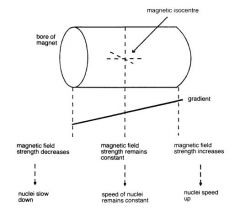
|
|
|
What happens to the protons above and below the isocenter
|
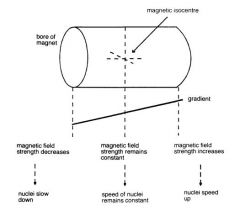
they will precess and a slower or faster frequency then that of the main magnetic field
|
|
|
What is the polarity of a gradient
|
The
direction of the gradient that determines which end is high and which end is low is called the polarity. |
|
|
What determines the polarity of the gradient
|
the direction of the current in the gradient coil
|
|
|
What happens to the precession frequency above and below the isocenter
|
Magnetic moments experiencing an increased field strength due to the
gradient speed up, i.e. their precessional frequency increases. . Magnetic moments experiencing a decreased magnetic field strength slow down, i.e. their precessional frequency decreases |
|
|
Since gradients can change the frequency of protons what does this mean
|
As gradients can cause nuclei to speed up or slow down, they can be
used to either dephase or rephase their magnetic moments |
|
|
How does the gradient cause dephasing
|
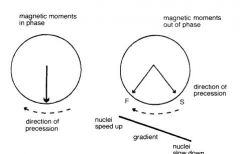
It all depends what condition the nuclei are in when the gradient is turned on. If they are inphase it will cause them to get out of phase. On the left the protons are in phase and therefore they will become out of phase (kinda how the positive lobe of the readout gradient gets every thing in phase and then out of phase)
|
|
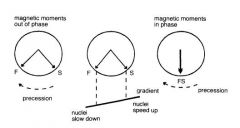
Now the gradient is causing rephasing
|

|
|
|
What are 2 ways that a gradient is faster
|
gradients rephase faster
smaller flip angle |
|
|
What is meant by the term saturation
|
this is when complete longitudinal relaxation does not occur in a single TR interval such that the next excitation will push the transverse magnetization beyond 90 degrees (thereby lessening its signal) to eventually it will go to 180 degrees where there is no signal .
|
|
|
IMPORTANT:Why are we able to shorten the TR interval in GRE
|
since the flip angle is smaller less time is required to get to longitudinal relaxation. This is important because it prevents saturation (which results in loss of signal) Therefore the TR interval can be small
|
|
|
What is the main disadvantage of GRE sequences
|
there is no compensation for magnetic field inhomogenities
|
|
|
What does saturation look like
|
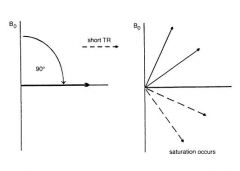
|
|
|
What does the TR control in gre
|
the amount of relaxation that occurs before the next pulse is applied
|
|
|
How is the T1 contrast of the image maximized in GRE
|
In order to maximise Tl differences, neither the fat nor
water vectors must have had time to recover full longitudinal magnetisa-tion before the next RF pulse is applied |
|
|
How is longitudinal relaxation prevented
|
To avoid full recovery, the flip
angle is large and the TR short |
|
|
How is the T2 effect minimized
|
To minimise T2*
differences, the TE is short so that neither fat nor water has had time to decay |
|
|
What is the objective behind maximized in GRE
|
To maximise T2* decay, the TE is long so that the fat and water vectors
have had time to decay sufficiently to show their decay differences. |
|
|
How is the T2 star effect increased
|
To
minimise Tl recovery, the flip angle is small and the TR long enough to permit full recovery of the fat and water vectors. |
|
|
How is the TE controlled
|
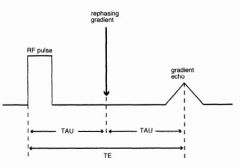
by adjusting the rephasing gradient timing
|
|
|
Does saturation occur with T2 weighting images
|

no
Also note how the TE time is longer (by slightly delaying the readout gradient) |
|
|
How is the T1 time decreased
|
To minimise Tl
recovery, the flip angle is small and the TR long enough to permit full recovery of longitudinal magnetisation. |
|
|
Can the TE be shorter than in regular spin echo sequences
|
yes, because the gradient will allow rephasing faster
|
|
|
How is T1 increased
|
by increasing the flip angle (saturation) and decreasing the TR. Also be shortening the TE time
|
|
|
How is T2 star increased
|
decreasing the flip angle
increasing the TR lengthen TE time where the contrast differences are greatest |
|
|
What are the typical values in GRE sequences
|
Long TR 100 ms+
Short TR less than 50 ms Short TE 5-10 ms Long TE 15-25 ms Low flip angles 5o-20o Large flip angles 70o-110o |
|
|
What is considered a long TR time in gradient echo
|
100ms or longer
|
|
|
What is considered a short TR time in gradient echo
|
less than 50ms
|
|
|
What is consideered a long TE in gradient echo
|
15-25ms
|
|
|
What is consdered a short TE in GRE
|
5-10
|
|
|
remember as saturation occurs then there will be decreased t2
|

|
|
|
Why is the frequency encoding gradient initialy applied negatively
|
The frequency encoding gradient is initially applied negatively to
speed up the dephasing of the FID, and then its polarity is reversed producing rephasing of the gradient echo |
|
|
What does a gradient echo sequence look like
|

|
|
|
What determines saturation of the transverse magnetization
|
flip angle and TR time. The more saturation the greater the T1
|
|
|
What does TE controld
|
The TE controls the amount of T2*
dephasing. To minimise T2* the TE should be short. To maximise it, the TE should be long. |
|
|
What causes steady state to occur
|
The steady state is a condition where the TR is shorter than the Tl and T2
times of the tissues. |
|
|
What is the result of steady state
|
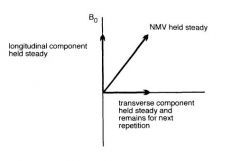
the longitudinal AND the transverse magnetization are held in a steady state
|
|
|
Is there time for the transverse magnetization to decay before the repeated flip angle
|
no
|
|
|
What are the standard parameters to achieve steady state
|
angles of 30°
to 45° in conjunction with a TR of 20 to 50 ms achieves the steady state. |
|
|
What is the transverse magnetization that is produced as a result of previous transverse magnetization called
|
This transverse magnetisation, produced as a result of
previous excitations, is called the residual transverse magnetisation. |
|
|
What is the appearance of fluid in SSGRE
|
It
affects image contrast as it results in tissues with long T2 times (such as fluid), appearing bright on the image. |
|
|
Why is SSGRE commonly used
|
Most gradient echo sequences use the steady state as the shortest TR
and scan time is achieved |
|
|
What is the fluid signal for coherent (inphase) gre sequences
|
Generally, in phase residual
transverse magnetisation gives tissues with a long T2 time a bright signal. |
|
|
What essential for the timing of the RF pulse in SSGRE
|
The steady state involves repeatedly applying RF pulses at time intervals
less than the T2 and T1 times of all the tissues |
|
|
What 2 signals are generated from SSGRE sequences
|
(1) a FID signal which occurs as a result of the withdrawal of the RF pulse
and contains T2* information, (2) a spin echo whose peak occurs at the same time as an RF pulse |
|
|
When does the spin echo signal of SSGRE occur
|
during the next RF pulse
|
|
|
How can a rephasing occur at the RF pulse if it is causing its own FID
|
This happens because every RF pulse (regardless of its net amplitude)
contains individual radio waves that have sufficient energy to rephase a previous FID |
|
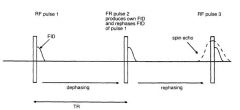
Note that there is an echo of the first FID that occurs during the next sequence
|

Note that the echo occurs during the 3rd RF pulse
|
|
|
What is the name of the echo that is produced in SSGRE
|
. The spin echoes produced are
sometimes called Hahn or stimulated echoes |
|
|
What is the T1 time of water, fat and CSF
|
2500 water
200 fat 2000 CSF |
|
|
What is the T2 time of water, fat and CSF
|
2500ms water
100ms fat 300ms CSF |
|
|
What is the TR equivalent to in SSGRE
|
the Tau of the spin echo
|
|
|
What is coherent gradient echo
|
Pulse sequences that use coherent magnetisation use a variable flip angle
excitation pulse followed by gradient rephasing, to produce a gradient echo |
|
|
Are coherent gradient echos steady state
|
yes
|
|
|
How is the residual magnetization in gradient echo kept coherent
|
These sequences keep this residual magnetisation coherent by a
process known as rewinding |
|
|
How does phase rewinding work
|
Rewinding is achieved by reversing the
slope of the phase encoding gradient after readout. This results in the residual magnetisation rephasing, so that it is in phase at the beginning of the next repetition. |
|
|
What does phase encoding look like
|

Rewinding is achieved by reversing the
slope of the phase encoding gradient after readout. This results in the residual magnetisation rephasing, so that it is in phase at the beginning of the next repetition. |
|
|
What is the appearance of a coherent GRE
|
Coherent gradient echo pulse sequences produce images that are T2* weighted . As fluid is bright they are often said to give an angiographic, myelographic or arthrographic effect.
|
|
|
What are the parameters of a coherent SSGRE
|
To maintain the steady state
Flip angles 30o-45o TR 20-50 ms To maximise T2* Long TE 15-25 ms |
|
|
What are the advantages of coherent SSGRE
|
Advantages
Very fast scans, breath holding possible Very sensitive to flow so good for angiography Can be acquired in a volume acquisition |
|
|
What does a coherent SSGRE study look like
|
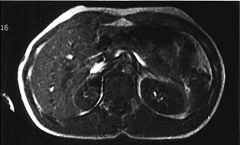
|
|
|
How do incoherent GRE sequences work
|
Pulse sequences that use incoherent residual transverse magnetisation,
begin with a variable flip angle excitation pulse, and use gradient rephasing to produce a gradient echo. |
|
|
How does the RF pulse in GRE spoiled sequences work
|
It does it by encoding the signal that is going to be received to a certain phase of the frequency. This means there is residual transverse magnetization but it is not detected by the reciever coil.
|
|

The top image shows that the RF pulse was in a certain phase and that phase will be recieved during the readout gradient like normal
|

The second RF pulse gives a different phase excitation. It does rephase the transverse magnetization of the previous pulse but since it is in a different phase it will not be detected at the end of the sequence
|
|
|
See ppt for gradient spoiling
|
yes
|
|
|
Why is gradient echo not good at measuring the T2 of a tissue
|
this is because the TE is very short and not longer than the approximately 70ms required for T2W imaging
|
|
|
What other factor contributes to the crappyness of T2 weighting in gradietn echo sequences
|
the gradient echo is very inefficient in eliminating magnetic inhomogenities and therefore the T2 star (magnetic inhomogenities dominate)
|
|
|
What is the function of the SSFP images (steady state free precession)
|
this sequence overcomes the problems with acquiring T2 during GRE
|
|
|
How does SSFP work
|
this works by eliminating the signal from the FID and only transmitting the frequency from the hahn (stimulated echo). This makes it sort of like a spin echo sequence except the echo is caused by the gradient.
|
|
|
What is the function of the rewinder gradient in the SSFP sequence
|
in order for this sequence to work the echo signal can not occur at the same time as the 3rd RF pulse. In order to have the echo signal occur earlier the 3rd RF pulse a rewinder gradient is used to speed up the rephasing of the protons.
|
|
|
How many TE's are there in SSFP
|
2
|
|
|
What are the 2 types of TE in SSFP
|
actual TE
effective TE |
|
|
What is the actual TE
|
this is the time from the echo (signal) to the next excitation pulse
|
|
|
What is the effective TE
|
this is from the initial RF pulse to the echo being measured (greater than TR)
|
|
|
What equation will give you effective TE
|
2 x TR - actual TE
actual TE is the time from the signal to the next RF pulse |
|
|
What is the function of the rewinder gradient in the SSFP sequence
|
to make it so the signal does not occur during the the 3rd RF pulse
|
|
|
By using the rewinder gradient to move the echo (signal) earlier what else is achieved besides moving the signal before the RF pulse
|
it gives the protons more time to dephase and therefore they can be T2 weighted.
|
|
|
Prior incorrect slide. The echo in steady state free precession is caused by an RF pulse not the gradient
|
ok
|
|
|
When is SSFP used
|
this is used in brains and knees with both 2D and 3D volumetric acquisition.
|
|
|
What has replaced SSFP imaging
|
FSE because better quality images with equal scan time
|
|
|
What is another type of imaging besides SSFP that use shifting of the echo
|
MR perfusion
|
|
|
So RF pulses have many different types of frequencies with the net pulse being the sum of these
|
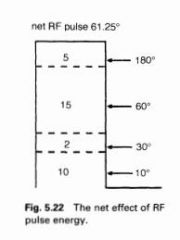
yes
|
|
|
How long does it take the FID to have a echo signal
|

at the same time as the 3rd RF pulse
|
|
|
What is done to overcome this problem
|

rewinder gradient
|
|
|
Is the FID signal used in SSFP
|
no, not a direct signal. The only signal detected is a result of the echo of the FID
|
|
|
What occurs at the RF pulse during SSFP
|
2 different many RF pulses are created but the important ones are the 180 for the spin echo and the small flip angle to create the FID
|
|
|
Why is the T2 signal in SSFP of better quality than regular GE
|
The rephasing has been initiated by an RF pulse rather than a gradient
so that more T2 and less T2* information is present. |
|
|
What 2 signals are produced in a steady state sequence
|
(1) a FID,
(2) a spin echo made up of the residual transverse magnetisation component. |
|
|
What signal is actually used in SSFP
|
the spin echo (FID is not directly used)
|
|
|
IMPORTANT: Gradient echo sequences are classified
according to whether the residual transverse magnetisation is in phase, (coherent), or out of phase, (incoherent). |
Gradient echo sequences are classified
according to whether the residual transverse magnetisation is in phase, (coherent), or out of phase, (incoherent). |
|
|
How is the residual transverse magnetization put in phase
|
rewinder gradient
|
|
|
What do in phase residual transverse magnetization look like when it is in phase
|
Generally, in phase residual
transverse magnetisation gives tissues with a long T2 time a bright signal. |
|
|
Do coherent steady state sequences have a high T2
|
yes
|
|
|
What are incoherent GRE sequences also known as
|
spoiled
|
|
|
Do incoherent pulses use FID only
|
yes
|
|
|
How do you differentiate the coherent steady state, spoiled steady state and SSFP
|
coherent- FID and spin echo
spoiled- FID only SSFP- Spin Echo only |

